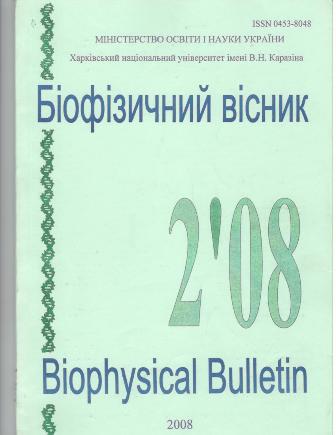Spectral behavior of amyloid-specific dyes in protein-lipid systems. III. Congor Red interactions with native proteins
Abstract
A number of so-called conformational diseases (Parkinson's, Alzheimer's and Huntington's diseases, type II diabetes, spongiform encephalopathies, systemic amyloidosis) are associated with the deposition in various tissues of highly-ordered protein aggregates (amyloid fibrils) that kill cells or prevent them from functioning properly. Amyloid fibrils are organized in a cross β-structure with a helical array of β-sheets, in which the long axis of the fibril is parallel to the long axis of the helix and is perpendicular to the βstrands Amyloid can be identified using a range of techniques: electron and atomic force microscopy, Xray fibril diffraction, thioflavin T fluorescence, Congo Red (CR) birefringence or spectrophotometric assay. However, therapeutic detection of amyloid fibrils with a CR test may be hampered by CR ability to form complexes with native proteins. In the present study, we investigated CR binding to a series of native proteins – hemoglobin (Hb), cytochrome c (cyt c), ribonuclease A (RNase), human serum albumin (HSA). CR interaction with Hb and cyt c was followed by absorbance decrease and long-wavelength shift of spectrum maximum in the case of Hb, indicating that native protein structure contains binding sites for CR. Association constant (Kb) and binding stoichiometry (n) recovered from the data analysis within the framework of Langmuir adsorption model were found to be: Kb=(2.1 ± 0.3)×105 M-1, n=3.3 ± 0.5 for Hb and Kb=(6.0 ± 0.9)×104 M-1, n=1.0 ± 0.3 for cyt c. The presence of lipid vesicles composed of phosphatidylcholine and cardiolipin did not exert influence on CR-Hb interactions. In contrast, the association constant for CR-cyt c complexation markedly increased. This finding was interpreted in terms of cyt c unfolding at lipid-water interface coupled with exposure of additional CR binding sites on the protein surface. The formation of CR complexes with RNase and HSA was followed by the long-wavelength shift of absorption maxima. CR-HSA binding curves have a Langmuir-like shape, whereas CR-RNase adsorption isotherms are slightly sigmoidal pointing to the cooperative nature of the binding process. The binding parameters were estimated to be Kb=(1.3 ± 0.3)×104 M-1, n=2.3 ± 0.5 for HAS and Kb=(3.4 ± 0.3)×104 M-1, n=0.6 ± 0.1 and Hill parameter α= 1.1±0.2 for RNase.
Downloads
References
2. M.R.H. Krebs, E.H.C. Bromley, A.M. Donald // J. Struct. Biol. 2005. 149. P. 30-37.
3. L.C. Serpell // Biochim. Biophys. Acta. 2000. V. 1502. P. 16–30.
4. W.E. Klunk, J.W. Pettegrew, D.A. Abraham // J. Histochem. Cytochem. 1989. V. 37. P. 1273-1281.
5. R. Khurana, V.N. Uversky, L. Nielsen, A.L. Fink // J. Biol. Chem. 2001. V. 276. P. 22715-22721.
6. G. Bartlett // J. Biol. Chem. 1959. V.234. P. 466-468.
7. H.K. Kimelberg // Moll. Cell. Biochem. 1976. V.10. P.171-190.
8. P. Mustonen, J.A. Virtanen, P.J. Somerharju, P.K.J. Kinnunen // Biochemistry. 1987. V. 26. P. 2991-2997.
9. T.J.T. Pinheiro // Biochimie. 1994. V. 76. 489-500.
10. J. Szebeni, H. Hauser, C.D. Eskelson, R.R. Watson, K.H. Winterhalter // Biochem. J. 1988. V. 27. P. 6425-
6434
11. O.K. Zakharenko, G.P. Gorbenko, V.M. Trusova, A.V. Finashin // Біофізичний вісник. 2008. 20. С. 37-40.
12. E.V. Dobrovolskaya, A.V. Yudintsev, O.K. Zakharenko, V.M. Trusova, G.P Gorbenko. // Біофізичний
вісник. 2007. Т. 19. С. 76
Authors who publish with this journal agree to the following terms:
- Authors retain copyright and grant the journal right of first publication with the work simultaneously licensed under a Creative Commons Attribution License that allows others to share the work with an acknowledgement of the work's authorship and initial publication in this journal.
- Authors are able to enter into separate, additional contractual arrangements for the non-exclusive distribution of the journal's published version of the work (e.g., post it to an institutional repository or publish it in a book), with an acknowledgement of its initial publication in this journal.
- Authors are permitted and encouraged to post their work online (e.g., in institutional repositories or on their website) prior to and during the submission process, as it can lead to productive exchanges, as well as earlier and greater citation of published work (See The Effect of Open Access).





